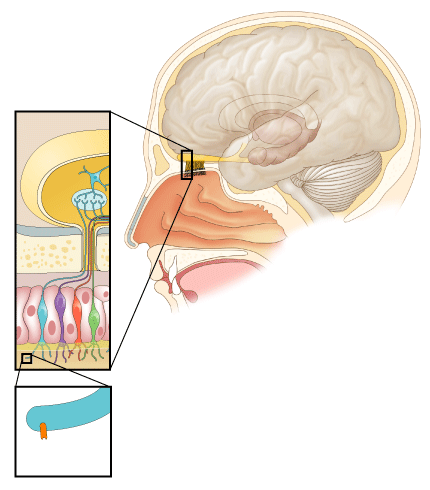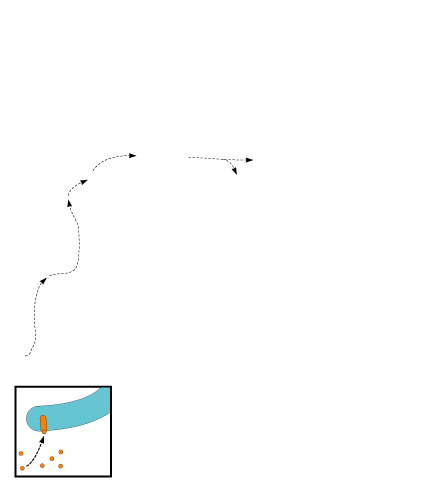Odor Adaptation and Habituation










Introduction: No Odorant
When you first enter a bakery, your nose will instantly react to the aromatic food molecules floating in the air. But if you sit down for a cup of coffee and stay for at least 15–20 minutes, you will find that your olfactory reaction becomes muted, or possibly switched off entirely. It’s not that the bread and pastries will start to smell bad; it’s just that you won’t smell them at all (or if you do, they will smell much less intense). This process is called odor adaptation.
If you take a job in the bakery, a different process called odor habituation will kick in once you have been working there for a few weeks. Now, you won’t even smell the bakery’s characteristic odors even when you first enter the bakery in the morning.
Instructions
The figure at left illustrates the mechanisms responsible for odor adaptation and habituation. Click the links to see and read about what happens when odorant molecules are presented to the olfactory system under “normal” conditions, after adaptation, and after habituation.
Normal Olfactory Sequence
Click the links in the description below to highlight each step in the normal olfaction sequence.
Under “normal” conditions—when you first walk into a bakery—odorant molecules make contact with receptor proteins embedded in the cell membranes of cilia at the bottom of olfactory sensory neurons (OSNs).
When an odorant molecule fits into a receptor protein, a chain reaction is started that sends an action potential up the length of the OSN’s axon. This axon synapses with mitral cells in a glomerulus of the olfactory bulb.
The mitral cell in turn sends a neural signal back to the amygdala or to the entorhinal cortex.
Once the signal reaches the brain, the smell is registered and elicits a cognitive reaction.
Olfactory Adaptation
Once you have been in the bakery for a few minutes, the odorants have been activating the receptor proteins in your nasal cavity so long that the receptor proteins react by burying themselves inside their cell bodies (bottom inset). As a result, the odorant molecules can no longer make contact with the receptors, and the whole olfactory process never gets started.
Adaptation occurs in olfaction for the same reason it happens in other senses. Much, if not most, of our sensory processing deals with detecting changes in our environment. Once the environment is stable, it is to our evolutionary advantage to stop sensing older stimuli and devote our resources elsewhere. In the bakery, you eventually will need to stop salivating over the chocolate croissants so that you can get your wallet out and buy one.
Another fairly common situation in which adaptation occurs (at least for men) is when one walks into an unsavory rest room. No matter how bad it smells, you have business to do, so you’re lucky that your olfactory system shuts down its processing of the odorant molecules in the room.
Olfactory Habituation
Click the links within the text below to see them highlighted in the figure at left.
After a few weeks of working in the bakery, your olfactory system may undergo two different transformations:
- The adaptation mechanism that you experienced before you started your career as a baker may have become semi-permanent. In essence, the receptor proteins become so exhausted that they stay inside the cell bodies permanently, so you are constantly adapted to the odorants. This fatigue is unlikely to become complete, however; when you first enter the bakery in the morning, a few odorant molecules are bound to activate OSNs and send signals up to the brain.
- Whatever signals do make it through to the brain, however, may have no effect when they get there because brain centers have (via some so far unknown mechanism) started to ignore them.
The result is habituation: You are effectively adapted to the bakery odors before you even walk in the door. Long-term habituation has the same survival value as short-term adaptation. If you are going to be smelling bread every day, your brain might as well not even bother processing the odor.
It takes weeks to de-habituate to a stimulus. If you were once a smoker and have since quit (or at least tried to quit for a few weeks), you will have a good sense for the changes that occur as you de-habituate to a particular odorant.